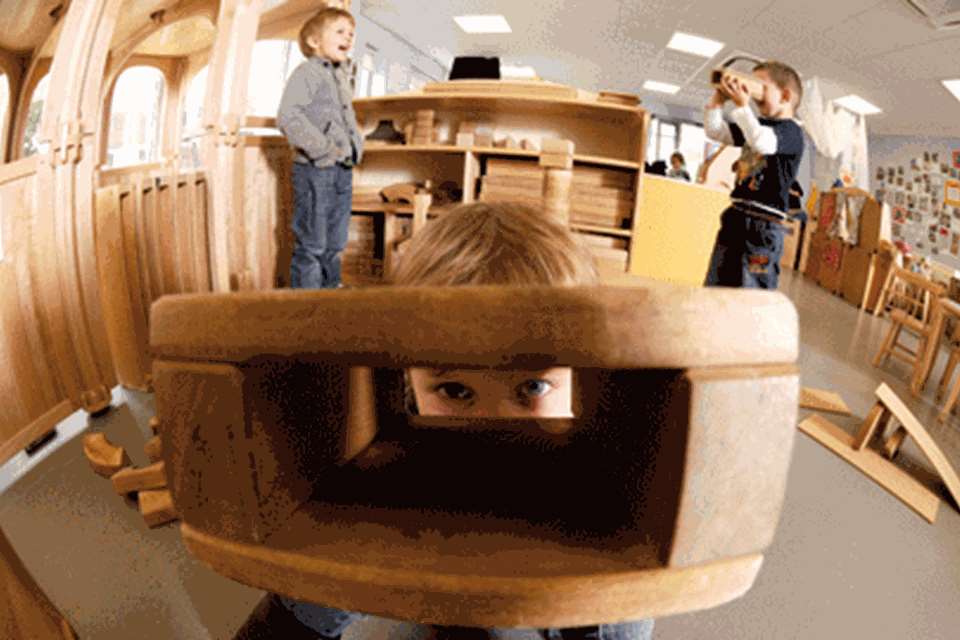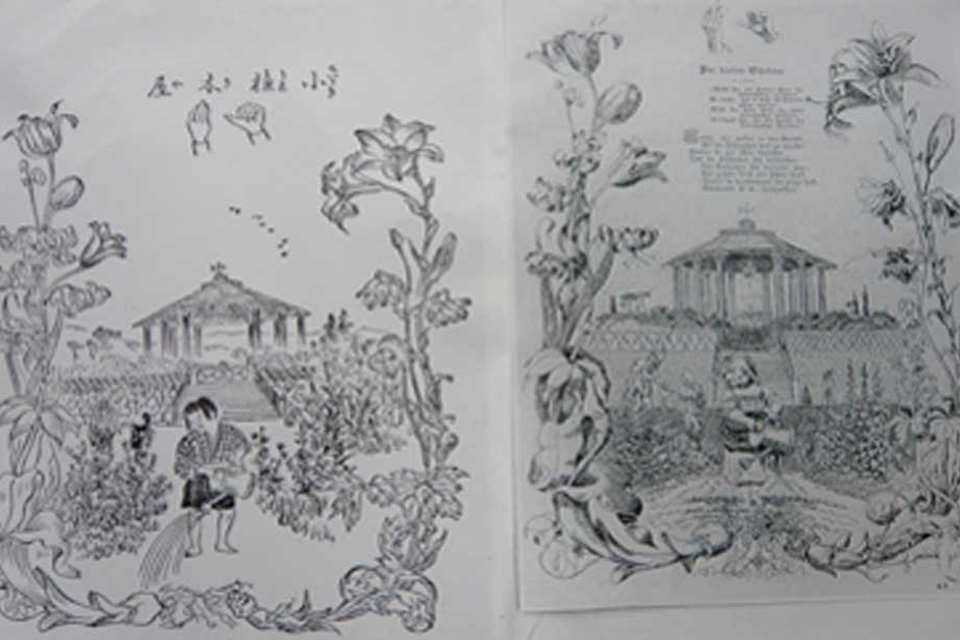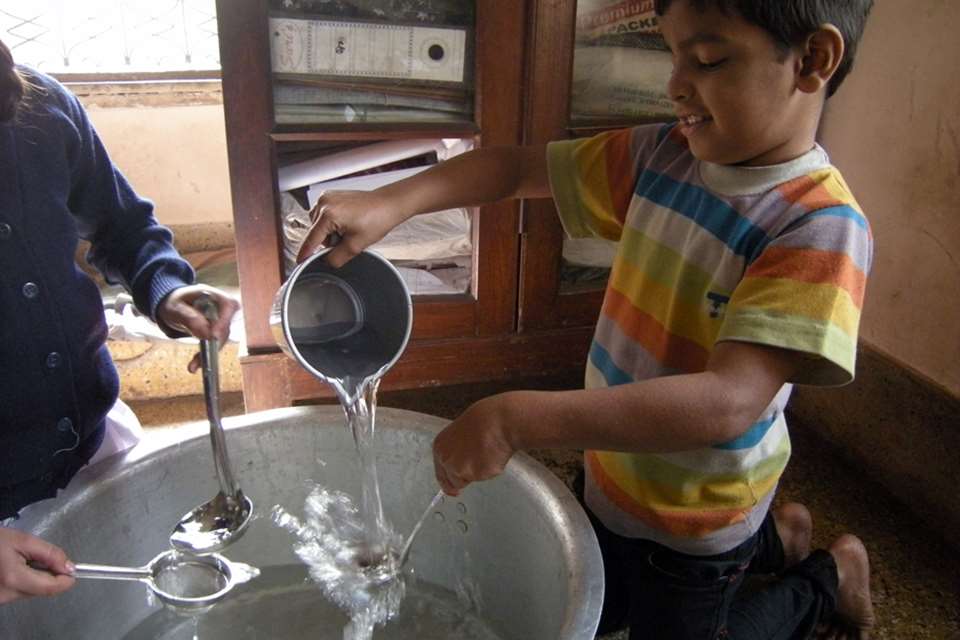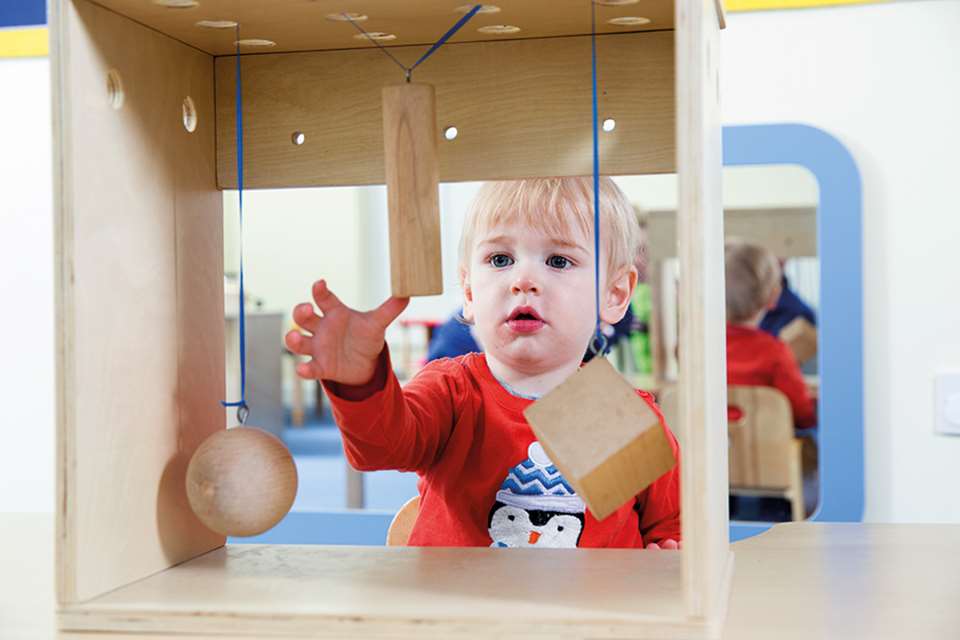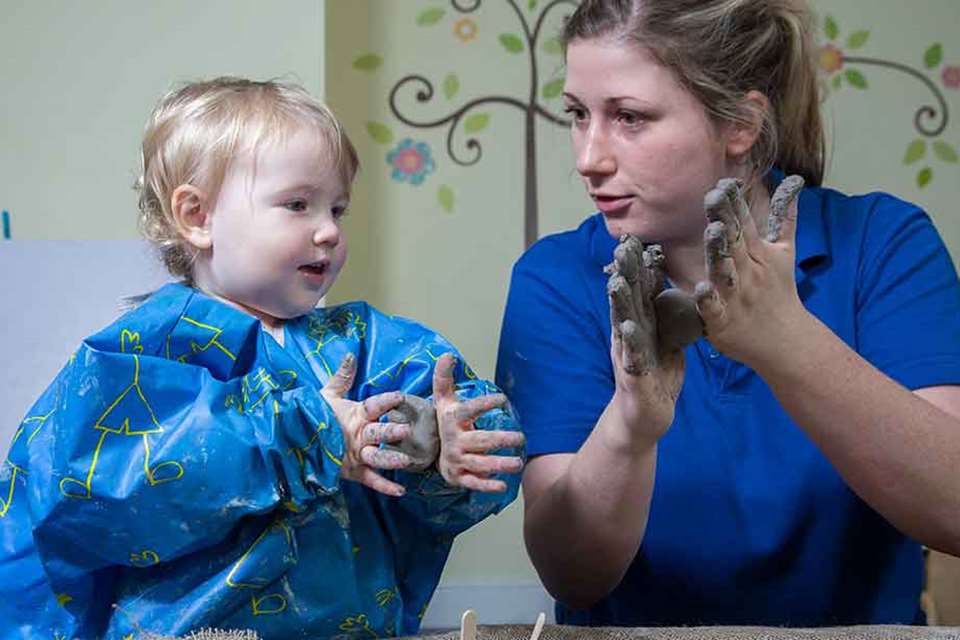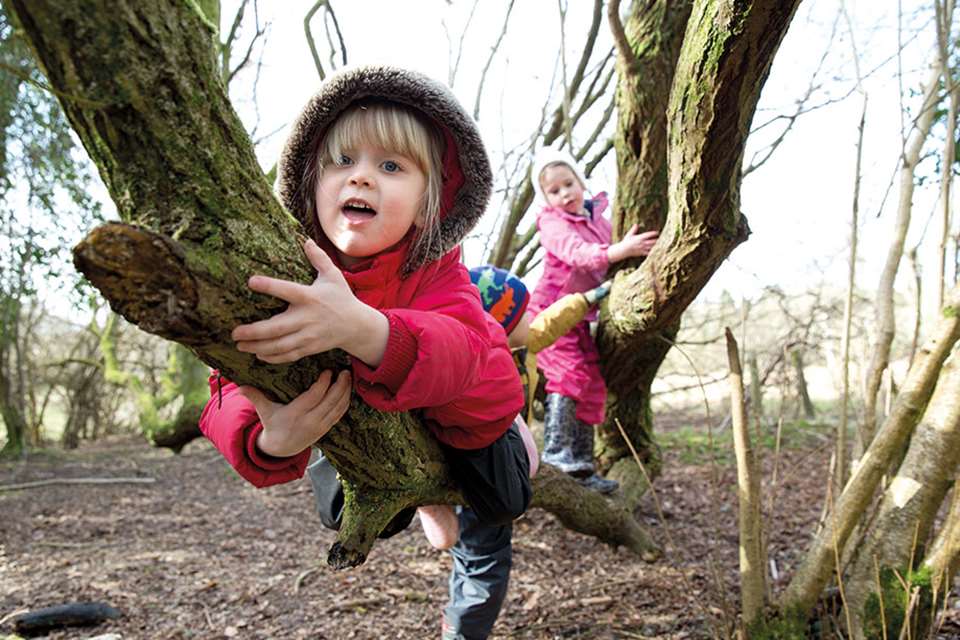EYFS Best Practice - Learning from Froebel… the symbolic life of the child
Professor Tina Bruce and Jane Dyke
Monday, April 17, 2017
How symbolism through play, music and stories encourages children’s creativity. By Professor Tina Bruce and Jane Dyke

A symbol is something that stands for something else. As soon as children begin to use symbols they are moving from the present, literal, concrete and real to something that is not necessarily present or real. They can think in more abstract and imaginative ways. They are no longer tied to the present. They are able to think, feel and remember the past and anticipate the future.
Froebel made it central in his approach to the education of young children from babyhood and through life. He said, ‘For what man tries to represent or do he begins to understand.’ Froebel did not see education as something only taking place in school. That would constitute narrow schooling rather than the kind of broad, rich and deep educational experiences that he wanted for children and their families. Froebel envisaged children growing up in a learning community, with family and school at the heart of this.
His last piece of work was the Mother Songs published in 1844. Just as all people are referred to as ‘he’ in the literature of the time, so parents were usually described as ‘Mother’. In reality, although Froebel certainly felt mothers were central in a child’s life, he also advocated the strength of family, including fathers, grandparents and siblings. He recognised the importance of babyhood, and how the family could help young children from an early age towards developing symbolic behaviour. The important thing about this is that family members have close, warm affectionate and intimate relationships with their babies and children.
CLOSE RELATIONSHIPS
The way parents sing to their children while changing them, feeding them, settling them to sleep or singing and talking to them in the pushchair is part of a close relationship. Being on a lap, pushing legs, tickling tummies and holding hands and feet during a song is at first uncomfortable for a baby who does not have a warm and affectionate relationship with the adult. The key person is of great importance for children in this situation.
Current researchers confirm what Froebel found to be important. One example is Colwyn Trevarthen’s work where he identifies the way baby and close adult move together in sharing a song, anticipate each other and look, take turns and respond to each other. Another is the research on ‘Mother Songs’ at Canterbury Christ Church University undertaken by Sacha Powell, Kathy Goouch and Louie Werth.
Froebel’s Mother Songs begin by helping the baby to become aware of their physical self. Songs such as ‘Round and round the garden like a teddy bear’ and ‘Pat a Cake’ do this. The hand becomes important, and again researchers such as Sally Goddard Blythe demonstrate the important links between hand, mouth and eye and how songs and physical movements help this along. At first the whole hand is used in Froebel’s Mother Songs such as ‘Here is a bee-hive’, with the hand bunched; and when the bees come out, the hand spreads out.
Froebel calls the songs using the hands ‘finger plays’. These help children to learn the names of different body parts. ‘Tommy Thumb’ is an example. He also links the ‘finger plays’ to nature (two little birds sitting on a wall), people (Antony Ayres went up the stairs), and everyday life (five fat sausages sizzling in a pan). From an early age the baby is encouraged to see the hands and body in a literal way, naming the parts. But the songs also offer non-literal ideas, and the fingers become birds, sausages, or a boy climbing upstairs.
On-the-spot and travelling, wandering songs (which Froebel called ‘Movement Games’) were aimed at children who could walk. They turn into stories, such as ‘A Princess lived in a high tower’, which become rehearsal for more complex stories such as Rapunzel and Sleeping Beauty. Froebel realised that children who are sung to and told stories begin to create their own characters and narratives. They become symbol-users because they are introduced to symbols appropriately, and they become symbol-makers and creators.
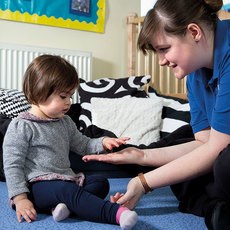
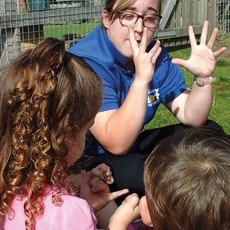 STRONG LINKS
STRONG LINKS
An important part of understanding the Froebelian approach to education is that everything links. Interconnectivity is key. The Mother Songs and Movement Games give children ideas and resources on which to draw so that they create their own ideas, moving steadily from the literal to the more abstract. But other elements of the Froebelian framework also do this, in entirely different ways. The Gifts (free-standing wooden blocks) and Occupations (which include clay, parquetry, stick-laying, weaving, sewing, paper-pricking, paper-folding, sand, water and construction kit) give children a wealth of opportunities and experiences that encourage the development of a creative symbolic life (see Parts 1 and 2 of this series).
Making dens in the garden and outdoor cooking with play scenarios using mud, sand, sticks and stones still chimes with the small-world play of the modern day, as well as role play and pretend play with dressing-up clothes.
The examples of the creative symbolic lives of children given so far have been quite tangible creations on the part of children, such as a model in clay, or a song they have made up, a dance they have developed, a painting of something, or a blockplay construction. But one of the most outstanding contributions of Froebel to the education of young children was his emphasis on the importance of play in taking children from the tangible to the abstract.
‘Play is the highest level of child development. It is the spontaneous expression of thought and feeling, and an expression which his inner life requires…It promotes enjoyment, satisfaction, serenity, and constitutes the source of all that can benefit the child…At this age play is never trivial; it is serious and deeply significant.’(Froebel in Lilley 1967).
This links with the thinking of Lev Vygotsky, who proposes that:
‘In play a child always behaves beyond his average age, above his daily behaviour; in play it is as though he were a head taller than himself. As in the focus of a magnifying glass, play contains all the developmental tendencies in a condensed form and is itself a major source of development’.(Vygotsky 1978).
Practitioners wishing to develop a Froebelian approach in the context of today find it helpful to use the 12 features of play identified (Bruce 2015) which connect Froebel’s view of play with current research. Helen Tovey (2016) has helpfully summarised these as choice and control in play, the absence of any pressure to conform to external rules and the importance of children keeping their own play agenda so that it is not taken over by adults.
Rich play develops when adults and children play together, respecting each other’s ideas. Play takes children into a world of pretence where they imagine other worlds and create stories of possible and imagined worlds beyond the here and now. Play is an integrating mechanism which helps children to co-ordinate their ideas and feelings and make sense of their relationships with family, friends and culture. It promotes flexible, adaptive, imaginative, innovative behaviour and makes children into whole people, able to keep balancing their lives in a fast-changing world.
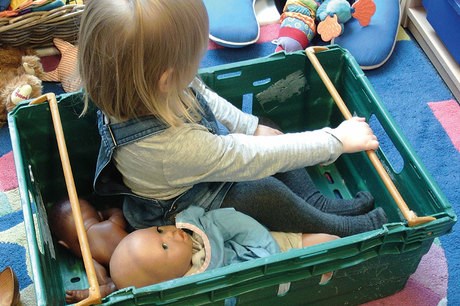
ADULT ROLE
The role of the adult is great in the Froebelian approach, contrary to the myth which suggests it is laissez-faire and Romantic. Froebel believed in ‘Freedom with Guidance’. This means the adult aims to give the right help in the right way at the right time. This is achieved through careful observation and tuning into the child’s interests, in a context where everything provided in the indoor and outdoor environment has been carefully thought through. Great attention is paid to giving children educationally worthwhile experiences.
Children are, then, in the light of what has been observed, supported and extended in their learning. Because of the subtle and nuanced ways in which Froebelian educators work with children, the huge role that they take is often not easy to discern. It looks as if children are creating models, paintings, pretend play scenarios, choreographing dances, composing songs and music without the help of adults. But without the adult support or encouragement to extend the symbolic behaviour would probably not be of such quality, or may not have developed at all. Adding to the material provision, or an appropriate conversation carefully introduced at the right time is probably the reason for a creative act of a child.
Stevie (three years) and her sister Lila (14 months), who live in Tower Hamlets, were taken on a short boat trip on the river, and saw various famous buildings such as Tower Bridge and the London Eye. At home that afternoon, Lila was helped by the adult to make a river scenario. The adult unrolled the kitchen roll to be the river. That was all that was needed. Stevie then spontaneously took from the recycled bin in the kitchen boxes which became boats, and a circular tin lid for the Eye. To an outsider it looked a mess. To Stevie and her adult play partner, it was a river with landmarks, and people going on river trips.
When the play faded, and the adult could intuitively ‘feel’ when that was, they put the bits and bobs in a shoe box so that it could be played with another day. The richer the child’s first-hand experience, the richer the symbolic life can become, helped by supportive adults.
Froebel believed that the task of education is to make the inner outer and the outer inner. Then we see the symbolic life of the child emerging, burgeoning and flourishing. But this needs the favourable conditions created by educators and families working together as a community of learners committed to the children.
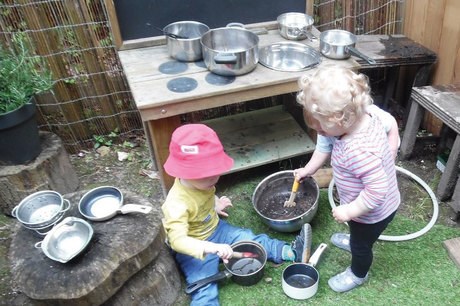
IN PRACTICE
Yellow Dot nurseries are learning from Froebel’s principles of music and play, explains Jane Dyke
I’d never really thought about where the song ‘Pat a cake’ had come from. Hearing that it was Froebel who had created the concept of children’s songs seemed strangely mind-blowing.
Yes, I knew nursery rhymes were important, and action songs and movement songs were all part of ‘good practice’ and the EYFS, but I hadn’t really thought about the why and the philosophy behind them.
Froebel said ‘link always link’, and many of his Mother Songs were connected to nature, occupations and everyday people’s jobs and roles. They were part of children’s everyday lives, giving a continual link to the Forms of Life, Knowledge and Beauty.
This way of thinking about the ‘content’ of songs we all found interesting and challenging. We had not really thought about whether babies, toddlers and young children, who have not experienced real life because they have only been alive for something between a few months and 60 months, might need to know about real things before they can imagine unreal things and play with ideas.
Did we really know what our children were singing and listening to in our nurseries and were we really offering educationally worthwhile experiences? Were we linking our learning as Froebel suggested we should? Were we actually introducing the abstract before children had established sufficient of the real?
‘We don’t know what we don’t know’, and nor do our children. We had our ‘light bulb’ moment when outdoors with a group of two-year-olds. We were in the local woods and the children found a frog – great excitement! Amy, our nature nursery manager, talked with the children about forgs and where they live, and asked if anyone knew what sort of sound frogs made. To her surprise and horror, the resounding reply was ‘tra la la la la’.
When she recounted this story to me I asked why on earth would they say ‘tra la la la la’? Amy replied because that is what we have taught them. I am completely confused at this point. And she starts singing:
‘Mmmm went the little green frog one day,
‘We know frogs go [action clap clap] tra la la la la,
‘They don’t go mmmm ahh.’
We both looked at each other in complete despair but also with complete clarity.
Froebel considered ‘content’ to be very important and that it should always be educational – ‘link always link’. This was a very tangible experience for us and one which we shared with our team at our development day. The song was a popular song in the toddler rooms and enjoyable to sing, but it is not ‘educationally worthwhile’ in important ways because it misleads children about how frogs are in reality, so why are we singing it? Once children know about real frogs and the sounds they make, it might be fun to sing the song because the children will know it is inaccurate, and an important part of pretend play is moving from the real to the imagined in creative ways. But perhaps in order to have that kind of fun, children need to know about the ‘frogginess of frogs’ first.
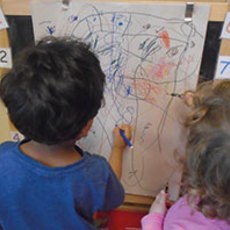 MUSIC MATTERS
MUSIC MATTERS
Froebel says we need to start where the learner is – so we needed to find out where we were. We asked the nurseries to ensure they had a music ambassador and to find out what we were singing and why.
Over time we are embedding the principles of Froebel:
Lullabies are important to babies to build attachment.
Finger rhymes/songs should have progression:
- Using hands – Open shut them
- Using fingers – Tommy thumb
- Crossing the midline – Wind the bobbin up
- Using the whole body – Head, shoulders, knees and toes
- Adding movement with the whole body – Dingle dangle scarecrow
The content of songs should chime with Life, Knowledge and Beauty.
Froebel believed that singing creates joy and a sense of community and cohesion. Within the nursery it can be an important way of creating attachments, calming and reassuring distressed children. Songs can create a rhythm to the day and can support flexible routines which give children a predictable environment. A singing voice is far more likely to gain attention and help get things done. By focusing more closely on what we are singing and why, we have definitely enhanced our practice and educational experience.
RICH PLAY
‘Rich play develops when adults and children play together, respecting each other’s ideas.’ When we heard Tina say this, we all agreed, but there was also a nagging doubt that this was actually happening. The introduction of Blocks and ‘Creative workshops’ was definitely redefining our open-ended play opportunities, and we were possibly playing alongside our children. But at best we were in the parallel play zone rather than ‘playing together’. On occasion, we were still patrolling a ‘school playtime’ rather than engaging with and developing play.
‘Everything provided in the indoor and outdoor environment [is] being carefully thought through’, but we were struggling with the ‘Freedom with Guidance’ aspect, which is central to the Froebelian principles and the role of the adult as part of that. Lots of us had to and still have to unlearn things we had been doing in the past. Some of us had/have to engage more with open-ended practice, careful observations, and provocation-based planning rather than outcome or activity-based planning.
It was interesting to reflect on our own development as practitioners. Froebel says that the adult should be ‘internally active and externally passive’, as Tina says this is carefully tuning into the child’s interests through careful observation. But some of us were feeling a little confused with finding ways of carrying out all this observation and reflection while we were actually playing with the children.
Some of us needed to hear that observation doesn’t always involve standing back and recording. ‘Taking note’ doesn’t literally mean writing down. Knowing and understanding your key children through actively playing with them is more important and valuable than writing copious notes and observations. Yes, there may be a minority of children who need more carefully recorded observations, but most of them need an active, supportive, encouraging, enabling adult to play with.
We need to learn that, yes, children need a rich environment to flourish, but they really need sensitive adults to ‘observe, support and extend’ (Bruce 1987) their play.
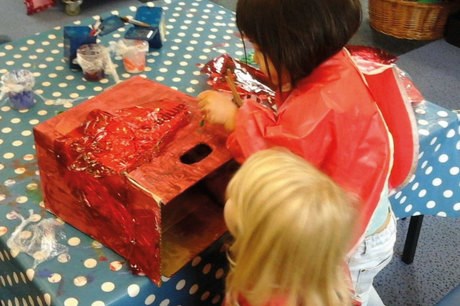
PARENTS: HOW TO ENJOY YOUR CHILD’S JOURNEY OF LEARNING TOGETHER
- Show you value what your child creates, especially if they have put effort into doing it. Try not to say ‘What is it?’ (It might never have been meant to ‘be’ anything.)
- Encourage your child to talk about the creation by saying something like, ‘That looks interesting, tell me about it.’
- Introduce vocabulary to enable your child to talk about their observations and experiences. For example, ‘smooth’, ‘shiny’, ‘rough’, ‘prickly’, ‘flat’, ‘patterned’, ‘jagged’, ‘bumpy’, ‘soft’ and ‘hard’.
- If possible, provide opportunities for mark-making activities at home. It does not have to be messy or expensive. Paper can be the back of old rolls of wallpaper or computer printouts.
- Three primary paint colours (red, yellow and blue) plus black and white will enable children to mix a wide range of colours, or you might prefer to provide felt pens or pencils. Keep your child company; you may be surprised to see how long they concentrate on this activity. Some children talk when drawing, colouring and ‘writing’. You can learn a lot about what your child is thinking and how they feel about the world during such times.
- Support your child in thinking about what they might want to make, the process that may be involved and the materials and resources they might need, such as a photograph to remind them what the climbing frame is like.
- If you have space, allow your child to collect things they like the look or feel of, such as leaves, scraps of fabric, lids and stoppers or packaging material. These can be glued into arrangements of the child’s choice, using a piece of card from a cereal packet and some PVA glue.
- Allow your child to explore music and movement to a range of genres of music. Your child may prefer to move to your rock music or sway to some jazz. It is good to let them explore their likes and dislikes of music and movement.
- Give your child the opportunity to explore rhythm and rhyme. Singing nursery rhymes or making up your own silly rhyme can encourage your child to keep a beat and explore sounds.
- Join in with your child’s role play and extend the story. Have you ever tried reversing roles, as your child may enjoy being the mummy or daddy while you cry and whine for your food?
- The Early Years Foundation Stage recognises seven areas of learning. Expressive Arts and Design is one of the four Specific Areas.
- Self-expression is an important aspect of life. Being creative means being able to take knowledge, ideas and materials and use them in a different way to make something new. It is needed therefore as much by scientists as artists.
- Creativity cannot be taught or forced, but it can be stimulated, supported, resourced and welcomed.
PAINTING: YELLOW DOT’S TOP TIPS
The possibilities for symbolic representation depends on a balance between child-initiated and adult-led activities. 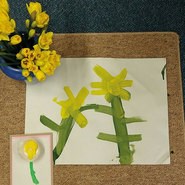
We need to ensure we offer opportunities for free painting and drawing underpinned by opportunities to introduce children to the skills they need, at the time they need them and in the way they need them, when painting and drawing.
Competent use of mark-making tools requires strong fine motor muscles in the fingers, hands and wrists. These can only be developed when opportunities have been given to build gross motor muscles of the core, tummy, shoulder and neck. Tummy time for babies is essential in ensuring children develop strong core muscles as well as strong shoulder and neck muscles. Toddlers need to experience painting activities that use whole-arm movements, such as painting on large pieces of paper and working at easels.
When we are planning painting activities we need to think about our role in supporting not only this muscle development but also the skills to handle the tools used and the composition of the paintings.
With the babies and toddlers, the practitioner role is about allowing the children to experience the paint and tools. But more essentially it is about talking to the children during the activity about what they are doing, the colours and tools they are using as well as the marks they are making. This dialogue will result in a more meaningful painting experience with the results produced reflecting this.
With the older children it is important for the practitioner to know when to be talking to the child about what they are painting, encouraging the child to think about the colours they are using and the marks they are making, and when to hold back and let the child be free. This allows the children to represent on paper their own personal experiences, and to articulate these if they wish, but without pressure.
That does not mean to say all paintings will look the same. In fact the opposite should be true as the practitioner tunes into what the child is saying about what they want to paint. To one child the practitioner can support the child painting a picture of mummy, talking about the colour of mummy’s skin and the shape of her face. For another child the conversation surrounding the painting will be about the fuzzy fur of the family dog and the number and shape of the legs required. Showing the children photographs and pictures of the real thing might be a help with this, but not necessarily when the child is engaged in the painting. The imagination might be more important than the accuracy. Think Life/Knowledge and Beauty.
It is the dialogue between the practitioner and the child that makes the difference to the quality of the painting. It is definitely not about the practitioner doing it for the child but rather the verbal encouragement given patiently and sensitively every step of the way.
ABOUT THIS SERIES
This six-part series aims to:
- convey Froebel’s continuing importance as an early years educator and thinker
- make links between the EYFS and Froebel’s principles and approach to early development and learning
- demonstrate ‘Froebel in action’ at Yellow Dot nurseries, Hampshire, which piloted training courses designed to help PVI settings embrace the Froebelian approach.
- Co-written by Froebelian expert Professor Tina Bruce and Yellow Dot founder and owner Jane Dyke, the six articles will cover:
- the Gifts
- the Occupations
- the place of nature in learning
- the symbolic life of the child
- the importance of nurture
- self-discipline rather than extrinsic motivation.
Linked to the series is a set of posters produced in association with Community Playthings (www.communityplaythings.co.uk), which will be taking part in this year’s bicentenary celebrations of the founding of Froebel’s school in Keilhau, Germany.
READING SUGGESTIONS
- Bruce T (2011) Cultivating Creativity: For Babies, Toddlers and Young Children. 2nd edn. Hodder Education
- Bruce T (2011) Learning Through Play: For Babies, Toddlers and Young Children. 2nd edn. Hodder Education
- Bruce T and Spratt J (2011) Essentials of Literacy from 0-7: A Whole-Child Approach to Communication, Language and Literacy. 2nd edn. Sage
- Bruce T (ed) (2012) Early Childhood Practice: Froebel Today. Sage
- Bruce T (2015) Early Childhood Education. 5th edn. Hodder Education
- Froebel F (1887) The Education of Man. Appleton
- Goddard Blythe S (2004) The Well Balanced Child: Movement and Early Learning. Hawthorn Press
- Lilley I (1967) Friedrich Froebel: A Selection from his Writings. Cambridge University Press
- Malloch S and Trevarthen C (eds) (2009) Communicative Musicality: Exploring the Basis of Human Companionship. Oxford University Press
- Powell S, Werth L and Goouch K (2013) Mother Songs in Daycarefor Babies. Report to the Froebel Trust Research Committee, Canterbury Christ Church University Research Centre for Children, Families and Communities
- Tovey H (2016) Bringing the Froebel Approach to Your Practice. 2nd edn. Routledge.
- Vygotsky L (1978) Mind in Society. Harvard University Press


